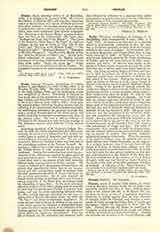

Cronan, name of several Irish saints.—I. Saint CRONAN MOCHUA, founder of the See of Balla, subsequently merged into that of Tui, Ireland, flourished in the period 596-637, d. March 30, 637, but his Acts are more or less of a legendary character. However, it would appear that he was educated at Bangor, under St. Comgall, and founded a monastery at Gael, among the Feara Rois of Louth and Monaghan, whence he migrated to Fore and Tehilly. Passing through Hy Many, he journeyed to Connacht, in 616, and founded the church and Abbey of Balla, of which he was first abbot-bishop. Numerous miracles are recorded of St. Cronan Mochua, and are minutely described in his Irish life. His feast is celebrated on March 30, though, through a misconception, his Acts are given by the Bollandists under date of January 1.
II. Saint CRONAN, Abbot–Bishop and Patron of Roscrea, a see afterwards incorporated in that of Killaloe, Ireland; b. in the territory of Ely O’Carroll; d. April 28, 640. After spending his youth in Connacht, he returned to his native district about the year 610 and founded the Abbey of Roscrea, where he established a famous school. Previously he settled at a place known as Sean ros or Loch Cre, a wooded morass far from the haunts of men; in fact, it was utterly wild, so much so, that St. Cronan abandoned it and moved to the wood of Cre, that is Ros ere, County Tipperary. Like those of so many other Irish saints the Acts of St. Cronan abound in miracles. The most surprising, perhaps, is the legend as to the transcribing of the Four Gospels by one of his monks, named Dimma. It appears that Dimma could only undertake one day’s task, from sunrise to sunset. St. Cronan, however, bade him write, and then Dimma set to work, never ceasing till he had finished the Four Gospels, the sun continuing to shine for the space of forty days and forty nights—the scribe himself being unconscious that the work had occupied more than a day. Whatever may be thought of this legend, it is certain that a magnificent Evangelistarium, known as the “Book of Dimma”, was for centuries preserved in St. Cronan’s Abbey at Roscrea, and is now in the library of Trinity College, Dublin. The scribe, Dimma MacNathi, signs his name at the conclusion of each of the Gospels, and he has been identified with Dimma, subsequently Bishop of connor, who is mentioned with St. Cronan in the letter of Pope John IV in 640, in regard to Pelagianism in Ireland, but this identification cannot be sustained. The case containing the “Book of Dimma” was richly gilt by order of O’Carroll, Lord of Ely, in the twelfth century. Notwithstanding the conflicting statements arising from the number of contemporary Irish saints bearing the name of Cronan, it is more than probable that St. Cronan of Roscrea, as les Petits Bollandistes say, lived as late as the year 640, and his death occurred on April 28 of that year. His feast is celebrated on April 28 and as such is included in all the Irish calendars, as also in the Kalendar of Drummond.
A number of other saints of this name find a place in Irish calendars. The three most important are St. Cronan Mochua, of Clashmore (February 10); St. Cronan, Abbot of Clonmacnoise (July 18); and St. Cronan, Abbot of Moville (September 7). Another saint frequently quoted as of this name is really St. Cuaran (Cuaranus Sapiens), whose feast occurs on February 9. There is also a St. Cronan Mochua of Sliabh Eibhlem (May 4).
W. H. GRATTAN-FLOOD

